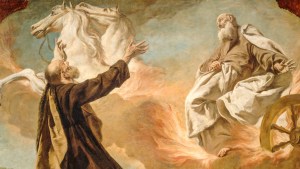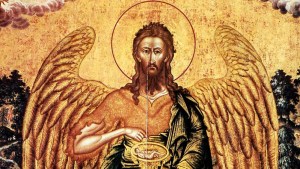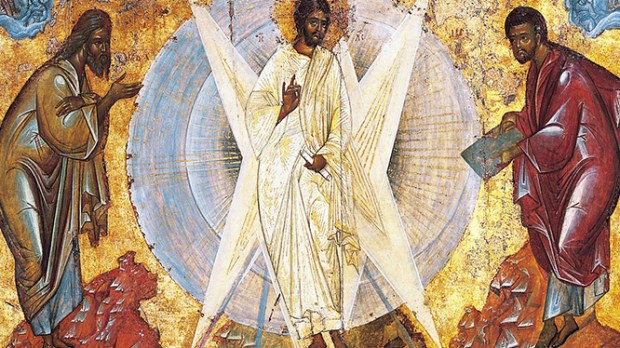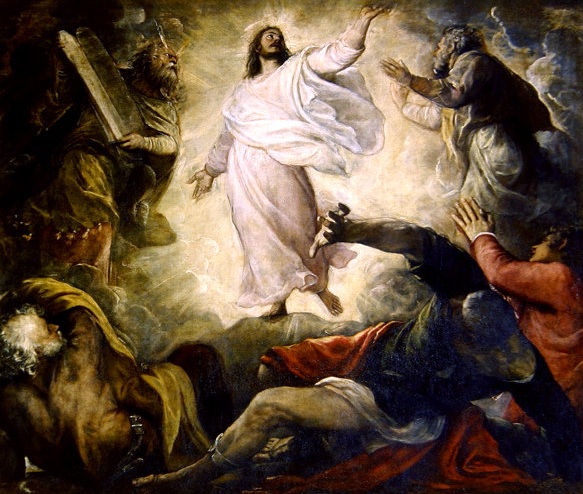The Transfiguration, the singular event in which Jesus appears radiant in glory upon the mountain, accompanied by Moses and Elijah, is minutely described in the Synoptic Gospels (Matthew, Mark, and Luke), mentioned in the second Epistle of Peter and, according to some, discreetly alluded to in John’s Gospel (“We have seen his glory, the glory of the one and only Son”), John being one of the three apostles who witnessed (with Peter and James) this miracle.
The Transfiguration is considered one of the five milestones of Jesus’ life according to the Gospels, alongside his Baptism, Crucifixion, Resurrection, and Ascension. Being the moment in which the divine nature of Jesus manifests itself through (or, perhaps more accurately, “in”) his human nature (hence implying some sort of prefiguration of the Resurrection, a “preview” of the glorified body), depictions of the Transfiguration throughout history have served as a model for later graphic representations of the Resurrection, suggesting this passage cannot be fully understood unless considered in the context of Jesus’ death (and his defeating death itself). The passage has surely also been read allegorically, as stressing the need for the transfiguration of the believer through the action of the Holy Spirit.
But Jesus and these three apostles (John, Peter, and James) are not the only characters involved in this scene. What are Moses and Elijah doing here, talking with Jesus?

Read more:
What is the difference between Elijah and Elisha?
We can somehow easily understand Moses’ presence. On the one hand, the Transfiguration occurs after Jesus feeds the hungry multitude, multiplying the loaves and fishes, which reminds us of the Israelites being fed with manna while led by Moses in the wilderness. Also, the Book of Exodus (34:29-35) tells us that when Moses came down from Sinai with the Ten Commandments “his face was radiant” (in fact, this passage is often referred to as “the radiant face of Moses”) just as Jesus’ face “shone like the sun” during his Transfiguration. These parallels would have surely been deeply and evidently meaningful not only for the authors of the gospels, but also for their early readers.
But there is one more interesting detail here: Luke’s Gospel (9:28-36) adds that Jesus, Moses, and Elijah were speaking about his departure (that is, Jesus’), “which he was about to bring to fulfillment at Jerusalem.” The Greek word Luke uses for “departure” in the original is exodos, an obvious allusion to Moses’ exodus out of Egypt. Here, the author is offering a clear reading of the history of salvation as going from Moses’ liberation to that offered by Jesus. But what about Elijah, then?
Here’s a hint: Elijah also “departed.”
Traditionally, the presence of Moses and Elijah in the Transfiguration has been read as summarizing “the Law and the Prophets” now being fulfilled in and by Jesus’ life, the Messiah. Moses is obviously representing the Law, while the Prophets are represented by Elijah. But why Elijah and not, let’s say, Isaiah, Hosea, or even John the Baptist, often referred to as “the last prophet of the Old Testament”?
Actually, according to the Catechism of the Catholic Church, John the Baptist is “more than a prophet.” In him, the Catechism continues, “the Holy Spirit concludes his speaking through the prophets. John completes the cycle of prophets begun by Elijah.” This is precisely what we find in the Gospel of Matthew (11:13-14): “For all the Prophets and the Law prophesied until John. And if you are willing to accept it, he is the Elijah who was to come.” But why was Elijah yet “to come,” if the Baptist is the “new” Elijah who already came? And why is he talking to Jesus?

Read more:
The reason John the Baptist has wings in Orthodox icons
The second book of Kings tells us the prophet did not die, but rather entered heaven alive “by fire,” “in a whirlwind,” carried away in a chariot of fire. Alongside Enoch and the Virgin Mary, he is the only other biblical character taken bodily into heaven. This passage is known as “Elijah’s departure,” and is also interpreted as a prefiguration of Jesus’ own Ascension into Heaven alive, once resurrected. It makes sense Elijah and Moses are then the two characters discussing Jesus’ own departure (exodos) as well.
But also, Elijah’s coming back has a deep eschatological meaning (both in the Hebrew and in the Christian Bibles) on its own, as his presence precedes that of the Messiah, and his “departure” prefigures Jesus’: the book of the prophet Malachi (the last prophet in the Old Testament in the Christian Bible, the book that closes prophetic literature) says Elijah will be sent back to earth “before the great and terrible day of the Lord comes.” It has been traditionally assumed, then, that the presence of Elijah in the Transfiguration reinforces the fulfilling of Malachi’s prophecy that had already been fulfilled with the Baptist, as if sealing it.
Make sure to visit the slideshow to see the most striking representations of the Transfiguration in Renaissance Art.


